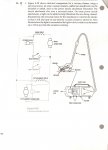newlearner
Member
- Location
- Chicago IL
Doing this experiment and have to connect a vacuum cleaner circuit with extra attachment. (Also had to add a light and a switch but, that is straightforward) This means there are two universal motors being used and two sets of field windings. During this whole lab, everything was connected in series so I'm thinking that is the way I would accomplish this. I'm second guessing myself now though. I'm thinking if I connect the motors in series, I will have 60 volts dropped across each one. I'm thinking I need to wire that in parallel so it will have the full 120 volts. Can someone set me straight?


